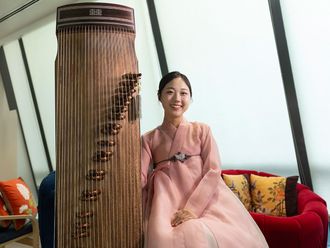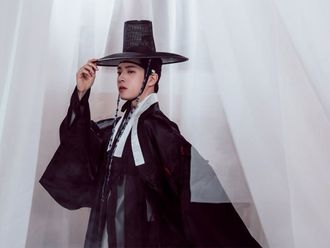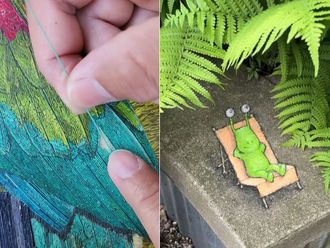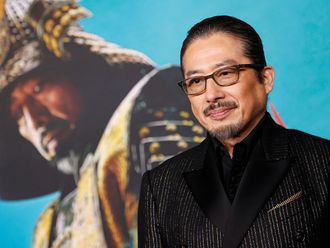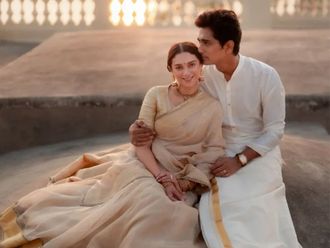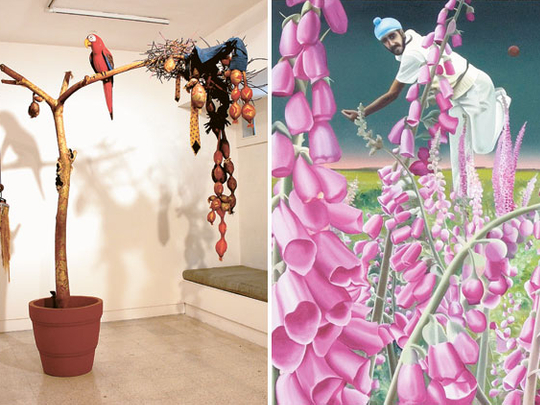
Rapid economic development and globalisation have brought about many changes in Indian society. They are reflected in the work of leading contemporary Indian artists Anju Dodiya, Chittrovanu Mazumdar, Jagannath Panda, Mithu Sen and Shibu Natesan. The five artists are showcasing their latest works in Dubai at an exhibition titled Terrestrial Bodies. Themes they have explored include the transformation in traditional attitudes, aspirations and lifestyles of Indians brought about by greater prosperity and international exposure, and the social and environmental effects of increasing urbanisation.
The artists come from different schools of thought and practice. The exhibition is thus a showcase of the depth and diversity of contemporary Indian art. Sen's installation is provocative and the show's most interactive. It deals with her favourite themes of femininity, interiority and sensuality and digs deep to reveal the innermost layers of our being and our society. Titled Reading Secrets of Others, the artwork comprises four books placed on a table, over which is draped a veil. Viewers are invited to enter the veiled area and use gloves to open the books. Inside each book is a mixed-media drawing with sensual undertones and velvet covering. Thus, by inviting viewers to be involved in this visual, tactile and rather private experience, the artist wants to question the concept, perception and experience of intimacy.
"My metaphorical drawings are very personal. They juxtapose desire with violence and express male and female perspectives of pleasure. The entire artwork is designed to create an intimate dialogue between the viewer and these concealed expressions of self. By placing the semi-transparent veil over the books, I have created a secret, safe private space within a public gallery for this interaction," Sen says.
Dodiya's work also explores internal and external reality, but as a detached observer. Her paintings are largely autobiographical, featuring self-images in intimate and sometimes theatrical situations.
The artist deftly weaves together stories about self and others to create fictional yet very real narratives. Her watercolour and charcoal painting in this show, titled Stars and Shells, uses simple yet powerful imagery to examine themes of beauty and violence, power and withdrawal, and the complexity of life and relationships.
Mazumdar's dramatic sculptural installations, made from metal and light bulbs, are also an expression of the artist's desire to discover hidden inner secrets and illuminate the truth. His latest creation, titled Honeycomb Lights, is a stunning combination of mild steel, aluminium foil and lights. The artist is also exhibiting a set of artworks created from traditional textiles and ornaments. "Every culture has a tradition of hand-woven and hand-embroidered textiles that are used in everyday life as wall hangings, quilts, cradle coverings or shrouds. Whether they are precious heirlooms or rustic decorations, these patiently created objects are an expression of love. They speak about our desire to protect, to give and to cherish, and about the human need to love," the artist says.
Panda's deep connection to traditional Indian society comes from the fact that he is the son of a temple priest. But his travels abroad and his experiences of living in a fast-growing suburb of New Delhi have given him a good understanding of modern, urban India. His complex collages portray the social, ecological and psychological cost of urbanisation. A recurring motif in his work is flowers. They symbolise nature, or rather the absence of it. But a significant part of temple rituals, the flowers refer to tradition and the artist's own background.
His latest collages feature a decorative piece, created from plastic flowers and a man-made beehive, towering above a concrete jungle of stark white buildings. They comment on the destruction of nature caused by urban expansion and consumerism along with our futile attempts to replace nature with synthetic replicas. In another piece titled House Plant, an exotic bird is perched on a bare plant, growing in a plastic pot. The plant is decorated with various objects ranging from neckties and shirts to magazines and fibreglass baubles.
"The materials I chose for this piece represent our dreams and desires in a globalised world. The exotic bird symbolises migrants who come from different corners of the world in pursuit of their dreams. The strips of fabric, ribbons, cutouts of pop-culture icons and magazines like Good Home are the bits and pieces of the desired abode that they are searching for. But these objects also signify the synthetic nature of urban life. What appears to be a simple tree is thus a complex hybrid of physical, mental and emotional narratives. It represents a delicate act of balancing the contradictions of urban topography and an amalgamation of tradition and modern pop culture," Panda says.
Similarly, Natesan's thought-provoking paintings juxtapose familiar media images with bold, colourful natural vistas to create a combination of hyper-realism and fantasy that forces viewers to think afresh about familiar issues. He is showing a new work from his well-known Each One Teach One series. The painting features a turbaned bowler in traditional cricketing whites amid a landscape of giant flowers, perhaps to draw attention to the loss of traditional values in the pursuit of economic prosperity. The artist is also displaying several portraits that comment on social, political and ideological issues of our times.
Jyoti Kalsi is an arts enthusiast based in Dubai.
Terrestrial Bodies will run at 1x1 art gallery, Al Quoz, until April 18.


